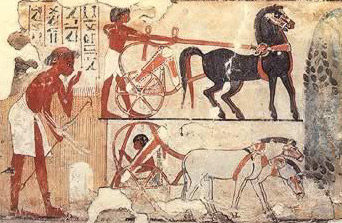HORSES OF KUSH & NUBIA
Nubians and Kushites were renowned horse masters. The Kingdom of Kush would trade them in peacetime, use them for chariots during war, and even domesticate them for daily use. The Kushite stallions, noted by their black coats and ivory legs, were famous throughout the ancient world in ancient Kemet, Rome, and Assyria. Those who worked with or handled horses were especially prized, and Kushites were known to serve as horse grooms, riders, trainers, breeders, and charioteers. Several ancient Assyrian documents such as the Nineveh Horse Reports of 8th century B.C. mention the superiority of the “horses of Kush” and record receiving numbers in the thousands through trade throughout the Assyrian empire. One neo-Assyrian text cites a Kushite horse expert and “chariot driver of the Prefect of the Land” holding a high office in the military. The Kingdom of Kush often traded luxuries such as ebony, ivory, and Kushite stallions to ancient Egypt. Pharaoh Piye’s Victory Stele lamented the condition of horses found starving in the stables of a recently conquered city of Egypt. Pharaoh Piye remarked “…As I live, as Re loves me, as my nose is rejuvenated with life, how much more painful it is in my heart that my horses have been starved than any other crime that you have committed at your discretion.” In the 8th century A.D., John the Deacon, an Egyptian chronicler of early Christian Nubian Kingdoms, made note of how highly trained the Nubian horse was. Nubian horses would kick enemies using their front and hind legs in battle while riders fought atop their backs. Pictured here is a painting of a horse drawn chariot part of a larger limestone fragment taken from the tomb of 18th dynasty official Nebamun.
Photo Credit: British Museum
For More Information: https://www.cambridge.org/core/journals/antiquity/article/symbolic-equids-and-kushite-state-formation-a-horse-burial-at-tombos/E8C2DC364A448C46421C693023B587F1/core-reader and https://www.journals.uchicago.edu/doi/pdfplus/10.1086/468525
